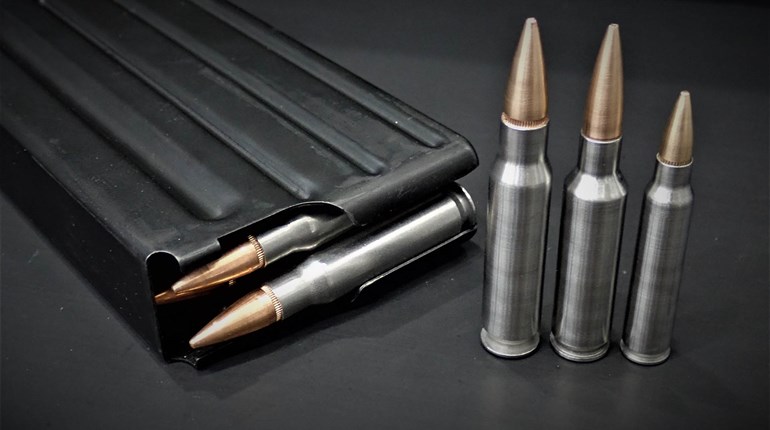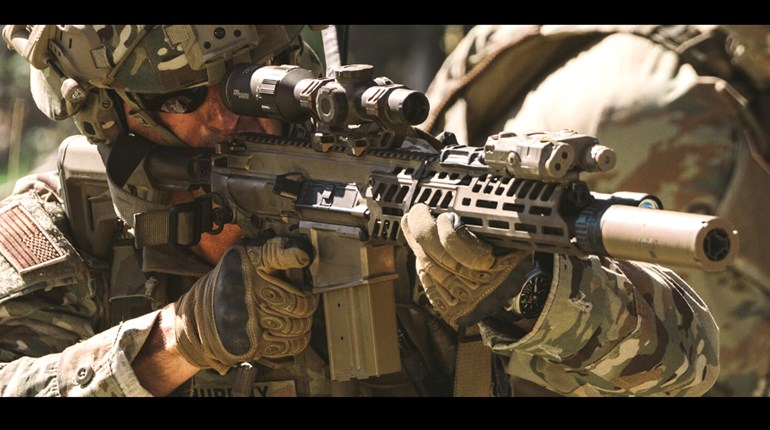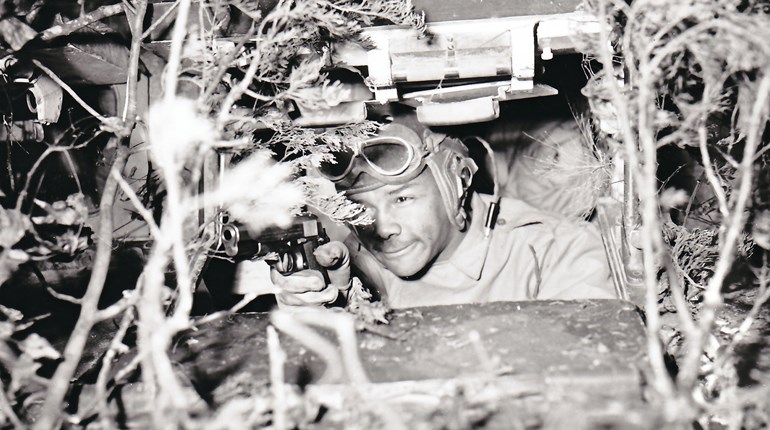
The lore filtered down from American ground forces in Vietnam—and later from those in Iraq, Afghanistan and other conflicts—was that the M16 and its related M4 platform worked well when they worked, but sometimes failed spectacularly under various combinations of dust, dirt and heat. Still, the U.S. Army has held onto those platforms for its Soldiers for nearly 60 years, until 2017, when the service pushed for more powerful ammunition than the traditional 5.56 NATO for which the platform is normally chambered. The new rounds in turn required new platforms, resulting in the Army’s Next Generation Squad Weapon (NGSW) program.
The program will place new firearms into the hands of Army front-line ground forces for the first time in decades. It aims to switch out the M4 carbine and the M249 SAW (Squad Automatic Weapon), which will be replaced by new carbines and light machine guns that use 6.8 mm projectiles and share a common small-arms fire-control system.
After a lengthy process that saw entrants dropped from the competition, the Army announced in April that it had chosen the entries from SIG Sauer.
“The XM5 Rifle will replace the M4/M4A1 carbine within the close-combat force, and the XM250 Automatic Rifle is the planned replacement for the M249 Squad Automatic Weapon,” the Army said on April 19. “Both weapons provide significant capability improvements in accuracy, range and overall lethality. They are lightweight, fire more lethal ammunition, mitigate recoil, provide improved barrel performance and include integrated muzzle sound and flash reduction.”
Both firearms fire a common 6.8 mm round, and are “more lethal against emerging threats than both the 5.56 [NATO] and 7.62 [NATO] ammunition,” the Army said.
The driving problem which the NGSW program was intended to solve was that the M4 with its 5.56 NATO round could not reliably pierce newer versions of Russian- or Chinese-made body armor worn by potential adversaries, particularly at longer ranges.
“The 5.56 round, we recognize there is a type of body armor it does not penetrate, and adversarial states are selling that stuff on the Internet for about 250 bucks,” GEN Mark Milley told the Senate Armed Services Committee in May 2017, when he was Chief of Staff of the Army. The service needed a more lethal round, he said.

The Army preferred a more dynamic projectile, in 6.8 mm. That intermediate caliber shoots farther at speed than a 5.56 NATO round, and can be controlled better than a 7.62 NATO, making it more accurate, insiders said. The service also looked carefully at the weight burden on troops and on transport.
“They wanted it to be lighter,” said military historian Jim Lechner. “This is part of trying to get away from soldiers having to carry a heavy slug and a brass cartridge. You multiply that by 2,000, and that becomes heavy. So, they’re trying to make the ammunition as light as possible.”
The Army began looking at composite-based projectiles to replace existing stocks of brass-cased ammunition. It discovered that with the new ammunition came the need for new platforms.
When announcing the NGSW program, the Army laid out the requirements for the new guns. The rifle must use 6.8 mm ammunition. The automatic rifle must be no longer than 35 inches and weigh no more than 12 pounds with attachments. It must be able to suppress targets from 3,900 feet, and fire accurately on targets 2,000 feet away.
Additionally, the guns must use a common fire-control between the rifle (NGSW-R) and the automatic rifle (NGSW-AR).
The NGSW program is a milestone in the annals of the armed forces, according to the winning competitor.
“The Army’s next gen program is the most audacious effort in decades,” said SIG Sauer President Ron Cohen, promoting his company’s product. “It is the ability to participate in writing history. And whatever happens now will dictate the next 20, 30, 40 years.”
The contract for the new fire-control system was awarded earlier this year to Vortex Optics. Its XM157 NGSW-FC was selected over the entry put forth by competitor L3Harris Technologies.
The Vortex system has multiple high-tech components. Its main feature is a variable-magnification optic with a backup etched reticle. Other advanced elements include a laser rangefinder, a ballistic calculator, atmospheric sensors, a compass and wireless communication. The system is “a ruggedized fire control that increases accuracy and lethality for the close-combat force,” according to a statement from Vortex Optics. The Army will pay between $20 million and $2.7 billion over the span of 10 years for the XM157 systems, depending upon the success of fielding the new firearms.
Also, earlier this year, Winchester—which currently operates the Lake City Ammunition Plant—announced that the Army awarded it $20 million in contracts “related to ammunition development, manufacturing facility requirements analysis and production capacity planning for the 6.8 mm Next Generation Squad Weapon (NGSW) program.”

While these contracts were announced first, the winning weapon platforms themselves took longer to decide. The final selection resulted from more than two years of technical and Soldier testing, said COL Scott Madore, the Army’s program manager for Soldier Lethality.
“We conducted numerous testing events that included over 1,000 soldiers and resulted in over 20,000 hours of Soldier feedback on the prototype systems during the competition,” Madore said while speaking on April 20, to reporters at the Pentagon. Along the way, feedback was sent to the manufacturers.
As the competition tightened, the entries from Textron Systems were discounted, the Army said, leaving finalists from SIG Sauer, along with those from True Velocity and its LoneStar Future Weapons team in partnership with Beretta USA.
The True Velocity/Beretta offering was based on a design originally from General Dynamics, using a bullpup configuration. The group’s RM277 rifle and its automatic rifle both use this design. Although the weapons themselves fall within the length requirement, the bullpup allows for a relatively longer barrel, with corresponding higher muzzle velocities and greater range. Advocates say the design also provides better balance.
Unlike other light machine guns that are belt-fed, these firearms feed from detachable magazines and come equipped with a bipod. Because the bullpup configuration handles differently from the standard design, troops would need to be further trained on using the new system.
This entrant used a new 6.8 mm composite-case cartridge designed and made by True Velocity. The ammunition can be used with current Army platforms, the company says, by switching barrels. Both of the company’s offerings were configured to fire True Velocity’s proprietary 6.8 TVCM composite-cased cartridge, according to an industry announcement about the partnership.
The partnership between True Velocity and Beretta will extend beyond the NGSW program, however, with Beretta USA leading the development of an export variant of the RM277 meant to be offered for sale to U.S. allies overseas.
SIG Sauer’s winning entries include a rifle based on the company’s existing MCX Rifle, along with a lightweight machine gun. SIG will make both the firearms and the corresponding ammunition in-house. The company’s new projectile features a hybrid 6.8x51 mm cartridge that is part composite-metal material and part traditional brass. The ammunition meets the Army’s requirement for lighter ammunition.

The rifle—now known as the XM5— is a short-stroke, gas-piston system with a 13-inch barrel and a collapsing buttstock that folds to the side. It is operated much like the M4 carbine that troops currently use.
SIG’s belt-fed Light Machine Gun-6.8 (LMG-6.8, now the XM250) is air cooled, fires from an open bolt and loads from the side, allowing easier access and more space for top-mounted attachments. Among its features are a folding design, a quick-detaching, low-toxicity suppressor and an internal recoil buffer.
The XM250 is light enough that it doesn’t have to be fired like a typical SAW, where the shooter is prone behind the weapon. The SIG version can be fired from different positions and still maintain accuracy, according to industry insiders.
The new NGSW program prompted years of speculation over which platform would make the final cut, using which caliber. Three years ago, contract-watchers at the annual Special Operations Forces Industry Conference (SOFIC) in Tampa, Florida interpreted a new Mk 48-variant machine gun from FN America to mean that the Army planned to buy a 6.5 Creedmoor-chambered weapon. The speculation, though, was premature; as the Army instead went with 6.8 caliber.
The concept of using ammunition larger than 5.56 NATO or smaller than 7.62 NATO isn’t new, according to Lechner.
“Ballistically, 6.8 and 6.5 mm munitions perform better than either 5.56 NATO below them, or 7.62 NATO above them,” Lechner said. The phenomenon has been known for nearly a century, he noted.
“Back in the 1930s the Army was going to choose a rifle” that eventually was used in World War II, Lechner said. “It came down to the M1 Garand, which used .30-’06 Sprg., and another that used a 6.8. The 6.8 performed better than the M1 Garand, but … the Army chose the M1,” likely because it had significant quantities of .30-’06 Sprg. ammunition stockpiled for the M1903 Springfield bolt-action rifles the Garand would replace.
The iconic rifle remained in service until 1958, when it was replaced by the M14, and then the M16. Neither used the ammunition that in the 1930s was found to be superior.
The NGSW competition overall has been a boost for industry and for shooters, one small-arms manufacturer told us.
“This has prompted the industry to think into the next level, for military and civilian consumers,” said the contact, whose company dropped out early in the process. “It will spill over to civilian sport shooters, giving them a larger variety of rifles to choose from.”
That was confirmed when SIG Sauer announced a civilian version of its NGSW entrant, the MCX-SPEAR, and also when Beretta announced it would work with
True Velocity and LoneStar to create a semi-automatic, civilian version of the RM277.
Now that the winner has been announced, the Army is looking at more bang, literally, for the buck. “The NGSW program significantly increases lethality and probability of hit at the squad level,” the Army said. “Due to the nature of the General-Purpose ammunition, the 6.8 mm projectile will outperform even the most modern 5.56 NATO and 7.62 NATO ammunition. These weapon systems will give soldiers significant capability improvements in accuracy, range, signature management and lethality.”
The challenge now is to ramp up ammunition production, Army officials said.
“The fielding of the weapon is based upon ammunition production,” BG Larry Burris told reporters. “What we don’t want to do is field capability to a unit where we don’t have training ammunition or contingency ammunition if required.”
“The real work of the ammunition community and the NGSW program goes on overdrive starting right now,” said BG William Boruff, the Army’s program executive officer for Armaments and Ammunition.
The Army has not yet announced which units will receive the new firearms, but they are expected to be frontline, close-combat troops, which include infantry and special operations forces. Other soldiers, meanwhile, will continue to use the M4 and the M249.
For the time being, the 1970s-era M240-series medium machine gun in 7.62 NATO will also remain in service. The manufacturer, FN America, was awarded a $49,973,579 firm-fixed-price contract in January 2022, for M240Ls with titanium receivers. That contract likely will be completed by January 2027.
The Army wants to initially buy 29,046 units of the SIG Sauer products, and the program is projected to cost $10 million in the first year, with a further $150 million spent in the year following. Keep reading Shooting Illustrated and ShootingIllustrated.com for full coverage of the NGSW program’s results, plus any firearm variants originating from the program that become available to the civilian market.
About the Author
Susan Katz Keating is the publisher and editor-in-chief of Soldier of Fortune magazine. She was a senior editor at the Washington Examiner, served as a military correspondent for People and has written for Time, RealClear and many other prominent national publications.




































